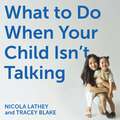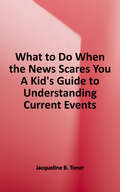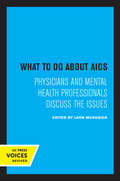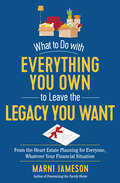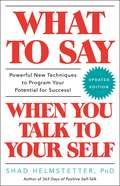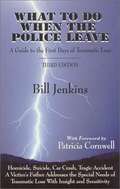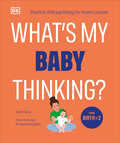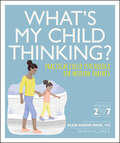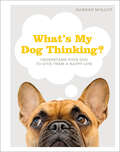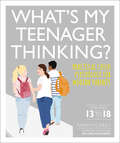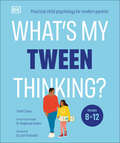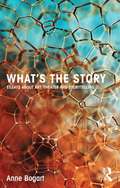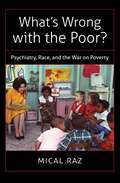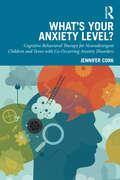- Table View
- List View
What to Do When Your Child Isn’t Talking: Expert Strategies to Help Your Baby or Toddler Talk, Overcome Speech Delay, & Build Language Skills for Life
by Nicola Lathey Tracey BlakeAn essential guide to language development - from babbling, to first words, to full sentences - plus, how to support the speech of autistic children or children with ADHD.The stress, anxiety, and isolation of the past few years have led to a crisis among young children. Many toddlers who had been chatting away stopped altogether while others never developed language skills at all. Speech and language therapist Nicola Lathey and journalist Tracey Blake are on a mission to get your child back on track--with strategies tailored to specific needs:- What if your baby isn't babbling in year one?- What if your toddler isn't saying their first words in year two?- What if your child isn't talking in sentences like their peers in year three?What to Do When Your Child Isn't Talking answers parents' burning questions about their child's development and provides expert strategies to put this advice into practice. With each chapter devoted to a language setback and solution, this book provides practical advice and fun games for parents to steer their children back on track and set them up for success at school and in life.(P) 2023 Tantor Audio
What to Do When the News Scares You: A Kid's Guide to Understanding Current Events
by Jacqueline B. TonerThis latest installment in the bestselling What To Do series tackles children’s feelings of anxiety around current events and what is portrayed in the news. Scary news is an inevitable part of life. This book can support and guide efforts to help scary news seem a bit more manageable for young people. <p><p> Whether from television news reports, the car radio, digital media, or adult discussions, children are often bombarded with information about the world around them. When the events being described include violence, extreme weather events, a disease outbreak, or discussions of more dispersed threats such as climate change, children may become frightened and overwhelmed. Parents and caregivers can be prepared to help them understand and process the messages around them by using this book. <p><p> What to Do When the News Scares You provides a way to help children put scary events into perspective. And, if children start to worry or become anxious about things they’ve heard, there are ideas to help them calm down and cope. This book also helps children identify reporters’ efforts to add excitement to the story which may also make threats seem more imminent, universal, and extreme. <p><p> Read and complete the activities in What to Do When the News Scares You with your child to help them to understand the news in context—who, what, where, when, how—as a means of introducing a sense of perspective.
What to Do about AIDS: Physicians and Mental Health Professionals Discuss the Issues
by Leon McKusickThis title is part of UC Press's Voices Revived program, which commemorates University of California Press’s mission to seek out and cultivate the brightest minds and give them voice, reach, and impact. Drawing on a backlist dating to 1893, Voices Revived makes high-quality, peer-reviewed scholarship accessible once again using print-on-demand technology. This title was originally published in 1986.
What to Do to Retire Successfully
by Martin B. GoldsteinSeventy-seven million baby boomers are slated to retire over the next twenty years: this boils down to approximately 10,000 daily (The Fiscal Times). Many are inadequately prepared, emotionally as well as financially. In What to Do to Retire Successfully, Goldstein lays out a step-by-step approach to achieving a successful and content retirement. Dr. Goldstein taps into his financial and psychiatry background as he explores the potential pitfalls of life after career's end, while providing helpful, proven solutions for a feasible and effective adjustment into retirement. He also analyzes how diverse personality types cope with retirement and suggests necessary modifications, as well as probing the unique problems of those forced into early retirement. In the financial realm, Dr. Goldstein offers specific formulas for continuance of comparable standard of living, steps for saving and investing, as well as tips for handling retirement resources. The lifestyle sections explore creating a dynamic plan for retirement living, the importance of setting up routines, keeping your mind engaged, daily exercise and making the necessary preparations needed to facilitate a successful transition into retirement living. What to Do to Retire Successfully is an englighting blend of actual retirement scenarios, intermingled with healthy, practical advice from a respected neuropsychiatrist, who is a fellow retiree, with a wonderfully optimistic glass half full philosophy towards living a fulfilling retirement life.
What to Do with Everything You Own to Leave the Legacy You Want: From-the-heart Estate Planning For Everyone, Whatever Your Financial Situation
by Marni JamesonYou can’t take it with you, but you can ensure that what you leave behind has value and meaning. Whether you want the fruits of your life’s work to benefit your family, the environment, science, human rights, the arts, your church, or another cause dear to you, one thing is certain: It won’t happen unless you plan. What to Do with Everything You Own to Leave the Legacy You Want is a step-by-step, DIY guide to turning your money and “stuff” into something meaningful that will outlast you—whether you are in the prime of life or your later years, single or partnered, have kids or not, are well-off or of modest means. With her trademark practical wisdom, downsizing expert Marni Jameson offers plenty of comfort (and even some laughs) as she guides you through the following: Identifying whom you want to benefit from your legacy Navigating wills, trusts, and other paths to your goals Heading off potential family conflicts Making the best plan for your material assets This book will encourage and inspire you through every step of your final downsizing project, helping you make a positive impact on the people and causes closest to your heart.
What to Say When You Talk to Your Self
by Shad Helmstetter<p>Discover Dr. Shad Helmstetter’s wildly popular self-help book What to Say When You Talk to Your Self, now updated with new information for the twenty-first century, and learn how to reverse the effects of negative self-talk and embrace a more positive, optimistic outlook on life! <p>We talk to ourselves all of the time, usually without realizing it. And most of what we tell ourselves is negative, counterproductive, and damaging, preventing us from enjoying a fulfilled and successful life. But with Shad Helmsetter’s Five Levels of Self-Talk (Negative Acceptance, Recognition and Need to Change, Decision to Change, The Better You, and Universal Affirmation), you can take back control of your life via this accessible yet profound technique. <p>Now filled with new and updated information perfect for the twenty-first century psyche, you can learn how to talk to your self in new ways, and jump-start a dramatic improvement in all areas of your life. So stop telling your self you can’t, and turn no into a resounding yes with What to Say When You Talk to Your Self!</p>
What to Say to Kids When Nothing Seems to Work: A Practical Guide for Parents and Caregivers
by Ashley Miller Adele LafranceWhat to Say to Kids When Nothing Seems to Work offers parents an effective, step-by-step guide to some of the most common struggles for kids aged 5–12. Written by mental health professionals with over 30 years’ experience listening to kids’ thoughts and feelings, this book provides a framework to explore new ways of responding to your child that will help them calm down faster and boost their resilience to stress. With a dose of humor and plenty of real-life examples, the authors will guide you to "build a bridge" into your child’s world to make sense of their emotions and behavior. Sample scenarios and scripts are provided for you to customize based on your caregiving style and your child’s personality. These are then followed by concrete support strategies to help you manage current and future situations in a way that leaves everyone feeling better. Chapters are organized by common kid-related issues so you can quickly find what’s relevant to you. Suitable for parents, grandparents, and other caregivers of children and pre-teens, as well as professionals working closely with families, What to Say to Kids When Nothing Seems to Work is an accessible resource for efficiently navigating the twists, turns, and sometimes total chaos of life with kids.
What to Think About Machines That Think: Today's Leading Thinkers on the Age of Machine Intelligence
by Mr John BrockmanAs the world becomes ever more dominated by technology, John Brockman’s latest addition to the acclaimed and bestselling “Edge Question Series” asks more than 175 leading scientists, philosophers, and artists: What do you think about machines that think? <P><P> The development of artificial intelligence has been a source of fascination and anxiety ever since Alan Turing formalized the concept in 1950. Today, Stephen Hawking believes that AI “could spell the end of the human race.” At the very least, its development raises complicated moral issues with powerful real-world implications—for us and for our machines. <P> In this volume, recording artist Brian Eno proposes that we’re already part of an AI: global civilization, or what TED curator Chris Anderson elsewhere calls the hive mind. And author Pamela McCorduck considers what drives us to pursue AI in the first place. <P> On the existential threat posed by superintelligent machines, Steven Pinker questions the likelihood of a robot uprising. Douglas Coupland traces discomfort with human-programmed AI to deeper fears about what constitutes “humanness.” Martin Rees predicts the end of organic thinking, while Daniel C. Dennett explains why he believes the Singularity might be an urban legend.
What to do When the Police Leave: A Guide to the First Days of Traumatic Loss (Third Edition)
by Bill JenkinsViolent death. . . the fear and legacy of our society. When a family is plunged into this nightmare, there are very few places to turn for assistance and guidance. This book is filled with simple, frank, and useful advice vital to families suffering a traumatic loss. Bill Jenkins' sixteen-year-old son was murdered on his second night of work at a restaurant. As one who has been there, he shares expert advice, lists helpful resources, de-mystifies legal and medical jargon and offers hope in the midst of tragedy.
What's Holding You Back? Eight Critical Choices For Women's Success: Eight Critical Choices For Women's Success
by Linda AustinThe first book to help women understand and shatter the psychological glass ceiling, the invisible but powerful thoughts and feelings that stand in the way of real achievement
What's Left of Human Nature?: A Post-Essentialist, Pluralist, and Interactive Account of a Contested Concept (Life and Mind: Philosophical Issues in Biology and Psychology)
by Maria KronfeldnerA philosophical account of human nature that defends the concept against dehumanization, Darwinian, and developmentalist challenges.Human nature has always been a foundational issue for philosophy. What does it mean to have a human nature? Is the concept the relic of a bygone age? What is the use of such a concept? What are the epistemic and ontological commitments people make when they use the concept? In What's Left of Human Nature? Maria Kronfeldner offers a philosophical account of human nature that defends the concept against contemporary criticism. In particular, she takes on challenges related to social misuse of the concept that dehumanizes those regarded as lacking human nature (the dehumanization challenge); the conflict between Darwinian thinking and essentialist concepts of human nature (the Darwinian challenge); and the consensus that evolution, heredity, and ontogenetic development result from nurture and nature.After answering each of these challenges, Kronfeldner presents a revisionist account of human nature that minimizes dehumanization and does not fall back on outdated biological ideas. Her account is post-essentialist because it eliminates the concept of an essence of being human; pluralist in that it argues that there are different things in the world that correspond to three different post-essentialist concepts of human nature; and interactive because it understands nature and nurture as interacting at the developmental, epigenetic, and evolutionary levels. On the basis of this, she introduces a dialectical concept of an ever-changing and “looping” human nature. Finally, noting the essentially contested character of the concept and the ambiguity and redundancy of the terminology, she wonders if we should simply eliminate the term “human nature” altogether.
What's Left of Me is Yours
by Stephanie ScottA BOOK OF THE YEAR FOR THE DAILY MAIL AND WOMAN AND HOMEA New York Times 'Editor's Pick'One of the Observer's Ten Best Debut Novelists of 2020Shortlisted for the Author's Club First Novel AwardLonglisted for the Jhalak PrizeLonglisted for the CWA John Creasy New Blood Dagger'Enrapturing... This richly imagined novel considers the many permutations of love and what we are capable of doing in its name' New York Times'A brilliant debut' Louise Doughty, author of Apple Tree Yard'You'll have the heart rate of an Olympic hurdler' Sunday Express'I read it with my heart in my throat' Sara Collins, author of The Confessions of Frannie Langton 'An exquisitely crafted masterpiece you'll be pressing into the hands of others' Woman & Home 'An intoxicatingly atmospheric mystery' Daily Mail'Dark, addictive and eye-opening, this is a brilliant debut' StylistA gripping debut set in modern-day Tokyo and inspired by a true crime, What's Left of Me Is Yours follows a young woman's search for the truth about her mother's life - and her murder.In Japan, a covert industry has grown up around the wakaresaseya (literally "breaker-upper"), a person hired by one spouse to seduce the other in order to gain the advantage in divorce proceedings.When Sato hires Kaitaro, a wakaresaseya agent, to have an affair with his wife, Rina, he assumes it will be an easy case. But Sato has never truly understood Rina or her desires and Kaitaro's job is to do exactly that - until he does it too well.While Rina remains ignorant of the circumstances that brought them together, she and Kaitaro fall in a desperate, singular love, setting in motion a series of violent acts that will forever haunt her daughter Sumiko's life.Told from alternating points of view and across the breathtaking landscapes of Japan, What's Left of Me Is Yours explores the thorny psychological and moral grounds of the actions we take in the name of love, asking where we draw the line between passion and possession.
What's My Baby Thinking?: Practical Child Psychology for Modern Parents
by Tanith CareyRight from the day your baby is born, they are thinking – they have a lot to learn and figure out!Your baby also has a strong desire to communicate, but it isn’t always easy to work out just what they are trying to tell you. In this fascinating, research-led book, parenting author Tanith Carey and Clinical Psychologist Dr Angharad Rudkin explain just what your new baby might be thinking, in 75 typical scenarios, from newborn to two years old.What’s My Baby Thinking? looks in depth at your baby’s brain development, the neuroscience of behavior, how babies learn, attachment and communication. It explores everyday parenting experiences, from birth to two, to help you see the world from your baby’s point of view. Written in an engaging Q&A format, the topics covered include: What is my baby looking at? Does my baby have favorite people? Can my baby understand what I’m saying? Why does my baby love peekaboo? Is my baby musical?In keeping with the series style, there are ‘Parenting survival guides’ throughout, for a deep dive into key topics such as Sleep Development, Twin Thinking and Separation Anxiety. Fully illustrated, and packed with practical advice on how to meet your baby’s developmental needs, this book will be a fascinating and useful book for all new parents.
What's My Cat Thinking?: Understand Your Cat to Give Them a Happy Life
by Jo LewisHave you ever wondered why your cats behave the way they do? This authoritative guide has all the answers! Cats are weird, and sometimes their behavior can leave you scratching your head. Discover what&’s really behind those things cats do – whether they&’re amusing, irritating or just downright bizarre.What&’s My Cat Thinking will help cat lovers unlock the secret code of cats for a deeper connection with the feline in your life. Inside, you&’ll find: • Accurate descriptions of behavior will help you understand your cat&’s body language nuances and act accordingly. • Covers a range of breeds. • A fun book for cat people that delivers practical, helpful advice from acknowledged experts on a range of tricky or puzzling cat behaviors. Have you ever wondered why your cat sleeps on your keyboard, why they bully the dog or why they insist on drinking from the bathroom tap — or if they even like you? Cats (unlike the dogs they look down on) are not always easy to understand. This cat psychology book will show you that they do show their feelings, albeit subtly, in the way they relate to you, other animals and their home environment. Stunning illustrations of a wide range of breeds and informative text will help you understand your cat's body language, so you know when they are happy and when they aren&’t! Aside from learning to understand your cat, this guide includes &“catwatching&” spreads that provide helpful tips and advice on dealing with some common kitty challenges like moving home and introducing a new cat into the family. So when they are sitting on your head at 4 a.m., you will at least know why!
What's My Child Thinking?: Practical Child Psychology for Modern Parents
by Eileen Kennedy-Moore Tanith CareyMake every moment with your child count. Tap into the psychology behind your child's behavior at every stage of development, and respond with confidence.Find out what your child really means when he says "Look what I did", "But I'm not tired," or "You're embarrassing me," and discover what's really going on when he can't express himself at all.Using more than 100 everyday scenarios, the book leads you through each one step by step, explaining not only your child's behavior and the psychology behind it but also your own feelings as a parent. It then gives instant recommendations for what you could say and do in response to best resolve the situation.Covering all your child's developmental milestones from ages 2 to 7 years, What's My Child Thinking? covers important issues, such as temper tantrums, friendships (real and imaginary), sibling rivalry, aggressive behavior, and peer pressure. There's also a bank of practical "survival guides" for critical times, such as traveling in the car, eating out, and going online safely. Rooted in evidence-based clinical psychology and championing positive parenting, What's My Child Thinking? will help you tune in to your child's innermost thoughts and be the parent you want to be.
What's My Dog Thinking?: Understand Your Dog to Give Them a Happy Life
by Hannah MolloyDiscover the true meaning of dog behavior to form the deepest bond with your canine companion.What does it really mean when a dog rolls over and shows their tummy? They're not always looking for a belly rub...Drawing on the latest research in dog psychology, this book reveals the secret meanings behind more than 80 canine behaviors, including the seven types of dog greetings and why some dogs eat your underwear!Packed with dog watching tips and positive reinforcement training advice, this book will help you keep your dog happy, stimulated - and adorable!
What's My Teenager Thinking: Practical Child Psychology for Modern Parents
by Tanith CareyAs the teenage brain rewires, hormones surge, and independence beckons, a perfect storm for family conflict emerges. Parenting just got tougher. But help is at hand.This uniquely practical parenting book for raising teenagers in today's world explores the science at work during this period of development, translates teenage behavior, and shows you how you can best respond as a parent - in the moment and the long term.Taking over 100 everyday scenarios, the book tackles real-world situations head-on - from what to do when your teenager slams their bedroom door in your face to how to handle worries about online safety, peer group pressure, school work, and sex.Discover how to create a supportive environment and communicate with confidence - to help your teenager manage whatever life brings.
What's My Tween Thinking?: Practical Child Psychology for Modern Parents
by Tanith CareyParenting just got tougher. As your child&’s brain rewires, hormones kick in, and independence beckons, a perfect storm for family conflict emerges. But help is at hand.Divided into two sections – aged 8 to 10 and aged 10 to 12 – this practical parenting book is grounded in evidence-based psychology, exploring the science at work during this period of your child&’s development.Taking 75 everyday scenarios, the book tackles real-world issues head-on, from sibling clashes and sulks to more serious concerns as your child edges towards their teenage years, such as handling anger, body consciousness, online safety, and self-harm.Discover how to create a supportive environment at home and how your behavior can help your tween manage whatever life throws at them as you also explore: -Difficult topics relevant to parents today, such as pornography and self-harm.-Everyday topics include clashes over sleepovers, first phones, homework, and going out with friends.-Content by Dr Angharad Rudkin, who is a child psychology expert, and Tanith Carey, a well-known parenting journalist who writes regularly for the Guardian.Building a strong relationship based on mutual trust and respect will ensure a smooth transition into your child&’s teenage years.
What's Normal Anyway? Celebrities' Own Stories of Mental Illness
by Anna Gekoski Steve BroomeNobody is immune from mental ill health, not even celebrities . . .We all know someone who suffers from mental illness. It may be a family member, friend, neighbour, or colleague. Now or in the future, it might be you. Here, for the first time, ten celebrities share their experiences of conditions including depression and anxiety, bipolar disorder and OCD, eating disorders and body dysmorphia. From Premiership footballer Dean Windass, to TV presenter Trisha Goddard, their candid first-person accounts detail the day-to-day reality of living with a mental health disorder, as well as the nervous breakdowns, stays in psychiatric hospitals, and suicide attempts. They also show that, ultimately, mental illness need not limit achievement, happiness, and fulfilment in life.These frank and honest stories help us to better understand mental illness, offer practical coping strategies, and give encouragement and solace for everyone out there who feels they are suffering alone. What?s Normal Anyway? shows that nobody is immune from mental ill health and shares powerful messages of positivity and hope.Contributors include: Bill Oddie, Alicia Douvall, Alastair Campbell, Stephanie Cole, Kevan Jones, Dean Windass, Trisha Goddard, Charles Walker, Tasha Danvers and Richard Mabey.
What's Normal Anyway? Celebrities' Own Stories of Mental Illness
by Anna Gekoski Steve BroomeNobody is immune from mental ill health, not even celebrities . . .We all know someone who suffers from mental illness. It may be a family member, friend, neighbour, or colleague. Now or in the future, it might be you. Here, for the first time, ten celebrities share their experiences of conditions including depression and anxiety, bipolar disorder and OCD, eating disorders and body dysmorphia. From Premiership footballer Dean Windass, to TV presenter Trisha Goddard, their candid first-person accounts detail the day-to-day reality of living with a mental health disorder, as well as the nervous breakdowns, stays in psychiatric hospitals, and suicide attempts. They also show that, ultimately, mental illness need not limit achievement, happiness, and fulfilment in life.These frank and honest stories help us to better understand mental illness, offer practical coping strategies, and give encouragement and solace for everyone out there who feels they are suffering alone. What’s Normal Anyway? shows that nobody is immune from mental ill health and shares powerful messages of positivity and hope.Contributors include: Bill Oddie, Alicia Douvall, Alastair Campbell, Stephanie Cole, Kevan Jones, Dean Windass, Trisha Goddard, Charles Walker, Tasha Danvers and Richard Mabey.
What's The Story: Essays About Art, Theater And Storytelling
by Anne BogartAnne Bogart is an award-winning theatre maker, and a best-selling writer of books about theatre, art, and cultural politics. In this her latest collection of essays she explores the story-telling impulse, and asks how she, as a ‘product of postmodernism’, can reconnect to the primal act of making meaning and telling stories. She also asks how theatre practitioners can think of themselves not as stagers of plays but ‘orchestrators of social interactions’ and participants in an on-going dialogue about the future.
What's Wrong With Addiction
by Helen KeaneThis is an impressive work: carefully structured, researched and written . . . a refreshingly lucid account that is both intellectually stimulating and professionally helpful.-Janet McCalman Addicts are generally regarded with either pity or grave disapproval. But is being addicted to something necessarily bad? These attitudes are explicit both in contemporary medical literature and in popular, self-help texts. We categorise addiction as unnatural, diseased and self-destructive. We demonise pleasure and desire, and view the addict as physically and morally damaged. Helen Keane's thought-provoking text examines these assumptions in a new light. In asserting that the 'wrongness' of addiction is not fixed or indeed obvious, she presents a refreshing challenge to more conventional accounts of addiction. She also investigates the notion that people can be addicted to eating, love and sex, just as they are to drugs and alcohol. What's Wrong with Addiction? shows that most of our ideas about addiction take certain ideals of health and normality for granted. It exposes strains in our society's oppositions between health and disease, between the natural and the artificial, between order and disorder, and between self and other.
What's Wrong with My Child?
by Elizabeth HarrisWhat’s Wrong with My Child? reveals a mother’s quest for answers about her son’s psych symptoms that leads to shocking discoveries that could impact struggling families in the United States and possibly globally. Elizabeth Harris’ son Cody was eleven when, out of the blue, he started exhibiting signs of Obsessive-Compulsive Disorder (OCD). The OCD turned into something far more sinister when Cody started having episodes where he seemed to lose total control over his actions, leading to Cody being committed to a county youth detention center. There, he was placed in solitary confinement for weeks. For five years, Elizabeth fought a hard battle to find out what was going on with her son and their family while simultaneously battling an unsympathetic judicial system. Driven to find a cure, Elizabeth visited countless doctors across the USA. She quickly became frustrated by the fact that there was no agreement in the medical community regarding PANDAS (Pediatric Autoimmune Neuropsychiatric Disorders Associated with Strep), the disease behind Cody’s transformation. In her quest for answers, this science-minded spa owner found proof of weaponized bacteria not only impacting their extended family, but that could be making families around the USA and possibly globally sick as well.
What's Wrong with the Poor?
by Mical RazIn the 1960s, policymakers and mental health experts joined forces to participate in President Lyndon Johnson's War on Poverty. In her insightful interdisciplinary history, physician and historian Mical Raz examines the interplay between psychiatric theory and social policy throughout that decade, ending with President Richard Nixon's 1971 veto of a bill that would have provided universal day care. She shows that this cooperation between mental health professionals and policymakers was based on an understanding of what poor men, women, and children lacked. This perception was rooted in psychiatric theories of deprivation focused on two overlapping sections of American society: the poor had less, and African Americans, disproportionately represented among America's poor, were seen as having practically nothing. Raz analyzes the political and cultural context that led child mental health experts, educators, and policymakers to embrace this deprivation-based theory and its translation into liberal social policy. Deprivation theory, she shows, continues to haunt social policy today, profoundly shaping how both health professionals and educators view children from low-income and culturally and linguistically diverse homes.
What's Your Anxiety Level? Cognitive Behavioral Therapy for Neurodivergent Children and Teens with Co-Occurring Anxiety Disorders
by Jennifer CorkThis book provides clinicians with a cognitive behavioral therapy (CBT)-informed curriculum specifically designed for neurodiverse children and teens with co-occurring anxiety disorders.Research has shown that neurodivergent individuals respond better to mental health interventions when they are adapted to their unique needs. The concepts and strategies in this book, guided by CBT principles, address these needs and provide clinicians with an affirming and supportive approach to treatment with neurodiverse clients. The visually engaging templates throughout help clients recognize and communicate their feelings with others, allowing them to self-regulate and feel their emotions, leading to a sense of achievement during treatment.A must-have resource on the bookshelf of any psychologist, social worker, counselor, and other professionals working with neurodivergent children and teens.
